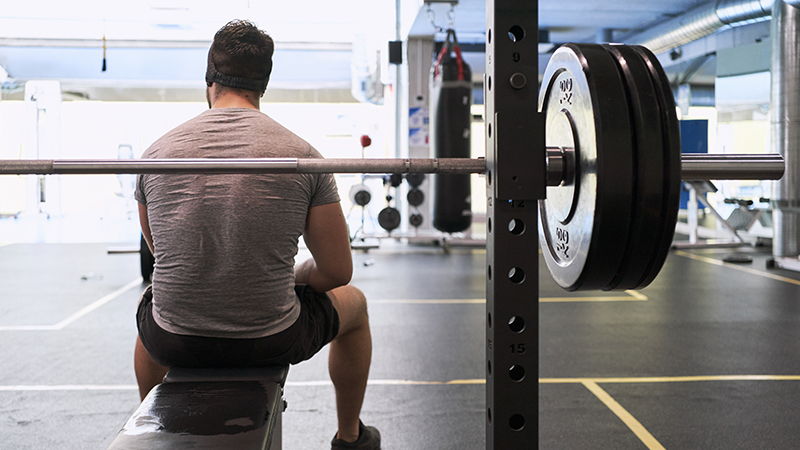Fitness Goals and How to Meet Them
Published June 2021
How Different Exercise Can Achieve Any Fitness Goal
Updated June 2021
Everyone needs a little exercise in their life. In fact, adults need approximately 150 minutes of moderate-intensity cardio activity or 75 minutes of high-intensity cardio activity each week, plus two days of strength training. And if you're not there yet — never fear. Whether it's the first of the year or the middle of the week, there's no bad time to work on your fitness goals. Getting enough exercise can be a stress-relieving, enjoyable part of your day.
Exercise is a necessary part of daily health, and if you do it correctly, you can leverage that time for your specific health goals. Here's how.
Exercise for Overall Wellness
If your objective is to simply live a happy, healthy lifestyle, exercise can help get you there. Try to hit the goal of 30 minutes of exercise five days a week, plus strength training. And if you don't have 30 minutes to spare, break it down into 10-minute increments. Take a brisk 10-minute walk during a break at work, park your car at the far end of the grocery store lot, take the stairs instead of the elevator or challenge yourself to doing 25 pushups before showering each morning.
And never underestimate the power of sleep. It's recommended that adults get 7-9 hours of sleep each night, which is necessary for muscle repair and growth. Sleep allows your brain to rest, and we all know that having a fresh, focused brain is key to answering tough questions like, "Do I hit the couch or the gym after work?"
Exercise for Longevity
Exercise might just add years to your life and life to your years. According to the American Heart Association, people who are physically active and at a healthy weight live about seven years longer than those who are inactive and obese.
And as a result, chances are those years will be good. Establishing a lifestyle of regular physical activity early can help counter conditions like obesity, high blood pressure and poor cholesterol levels that could mean stroke and heart attack in your later years. A lifelong exercise routine can also help prevent chronic diseases associated with aging. This means a better quality of life and more independence for seniors.
What can you do specifically to help increase your lifespan? The trusty standard still needs to be followed (150 minutes of moderate-intensity cardio or 75 minutes of high-intensity cardio per week), and pay special attention to the recommended two strength-training sessions each week. To avoid osteoporosis, a bone disease that can lead to debilitating falls and health issues, weight-bearing and muscle-strengthening exercises are very important; they help build and maintain bone density and keep your bones strong.
Examples of weight-bearing exercises include dancing, hiking, jogging, jumping rope, playing tennis, walking, or using elliptical and stair machines. Muscle-strengthening exercises include lifting weights, using resistance bands and doing bodyweight exercises like planks. All of these exercises can be done at any intensity to accommodate all levels of physical activity. The most important thing is to start moving, and stay moving.
Exercise for Weight Management
Maintaining a healthy weight is very important to overall health and can help prevent and control such serious issues as heart disease, diabetes, certain cancers, breathing problems and injury.
Whether you're looking to maintain weight or lose weight, it's important to remember that there's no magic routine that will guarantee success. But, working out is a huge part of the equation. While cardio is a necessity, you can intensify your workout with interval training. Interval training consists of periods of high- or maximal-effort exercise with lower-intensity recovery periods. Intervals also can be done anywhere, including outside, on a treadmill, bike, rowing machine, elliptical and other fitness machines.
The U.S. Department of Health and Human Services offers a general rule for judging the intensity of your exercise. Someone doing moderate-intensity aerobic activity can talk, but not sing, during the activity. The intensity of the activity is considered vigorous, or high, if you cannot say more than a few words while doing it without pausing for a breath. If you're unsure what level of intensity to target, start slowly and go at your own pace. Soon enough, you'll be learning more about your body, and you can build up intensity.
Resistance training is also a must. Focus on compound movements like squats, lunges, deadlifts and rows that engage multiple muscle groups at the same time, and burn more calories than isolated movements. And the best part? Compound exercises are very efficient, allowing you to maximize benefits in less time.
Adding a yoga class or two to your weekly routine can work wonders if you're feeling stressed. Stress is the enemy when it comes to weight loss. It causes a release of hormones and cortisol, which can cause excessive hunger and food cravings. A stressed body wants to hold on to fat, which is the opposite of what you want.
Remember that diet and fitness go hand in hand when it comes to weight management. You can spend hours sweating in the gym, but if you eat a lot of highly processed, calorie-dense foods, you probably won't get the results you're after. Eating a balanced diet with the addition of foods like black beans (one cup packs 15 grams of protein and no saturated fat), oats (includes a healthy carb that boosts metabolism and burns fat), avocados (packed with fiber, protein and healthy fats that combat hunger) and blueberries (high in antioxidants and fiber) can help rev up your metabolism and keep you feeling fuller longer.
Exercise for Strength
While the exact science behind weight training to build strength is slightly different from the science behind weight training to gain muscle, the main idea behind them is the same. Weight lifting, no matter what your goal, is beneficial for many reasons. It increases HDL (good) cholesterol and reduces LDL (bad) cholesterol; reduces risk of getting diabetes, cardiovascular disease and breast cancer; and increases your flexibility and ability to perform everyday tasks.
If your goal is to build strength, use small amounts of weight to start. Keep focus on your form, and add more weight slowly, over time. Be sure to pay attention to your body's response; exhaustion, sore joints or muscle pain might mean that you're overdoing it.
No matter what your fitness ambitions are, talk with a physician before starting any fitness program, especially if you're devoted to a specific goal. The amount you eat, your body weight, your fitness goals and the intensity of your training can all matter. To get the best results, a lifestyle medicine specialist can help you devise a program that incorporates the right exercises, the right food and the right timing. It's important to start slowly, move at your own pace, and enjoy the physical, mental and emotional transformation that comes with a healthy lifestyle.





